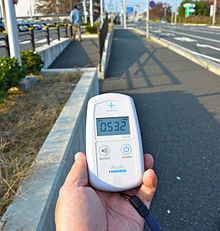- Flower Sakura Local time Monday 6:36 AM | - Tree Japanese Zelkova Population 56,979 (Oct 2016) | |
 | ||
Weather 2°C, Wind S at 11 km/h, 88% Humidity Points of interest Higashigaoka Park, Sōmakodaka Shrine, Kinshoji, Kashimamiko Shrine | ||
Minamisōma (南相馬市, Minamisōma-shi) is a city located in Fukushima Prefecture, in northern Honshū, Japan. As of October 2016, the city had an estimated population of 56,979 and a population density of 140 persons per km². The total area was 398.50 km².
Contents
- Map of Minamisoma Fukushima Prefecture Japan
- Geography
- Neighboring municipalities
- History
- 2011 earthquake and tsunami
- Education
- Railway
- Highway
- Sister city relations
- References
Map of Minamisoma, Fukushima Prefecture, Japan
Geography
Minamisōma is located in northeastern Fukushima Prefecture, bordered by the Pacific Ocean to the east and the Abukuma Plateau to the west.
Neighboring municipalities
History
The area of present-day Minamisōma was part of ancient Mutsu Province, and has been settled since at least the Jomon period. Numerous Kofun period remains have been found in the area. During the Edo period, much of the area was part of the holdings of Sōma Domain. After the Meiji Restoration, it was organized as part of Iwaki Province. With the establishment of the municipalities system on April 1, 1896, the area was organized into a number of towns and villages within Sōma District, including the town of Hara on September 1, 1897. Hara was raised to city status on March 20, 1954, being the city of Haramachi, . The modern city of Minamisōma was established on January 1, 2006, from the merger of Haramachi and the towns of Kashima and Odaka (both from Sōma District).
2011 earthquake and tsunami
Minamisōma was partially inundated by the tsunami which resulted from the Tōhoku earthquake on March 11, 2011, and suffered heavy damage. As of April 9, 2011, 400 residents were confirmed dead, with 1,100 missing.
In wake of Fukushima disaster, Japan raised 'safe' levels of radiation exposure from 100 millirems per year (1 millisievert/yr) to 2,000 millirems per year (20 millisieverts/year).
Minamisōma is about 25 kilometres (16 miles) north of Fukushima I Nuclear Power Plant, the site of the nuclear accident that followed the 2011 Tōhoku earthquake and tsunami. Much of the city lies within the mandated evacuation zone near the plant, and thus most of the residents were forced to leave. Approximately a week after the earthquake Minamisōma was in the news again as the town's mayor Katsunobu Sakarai asserted that his people had been "abandoned" in the wake of orders for all remaining residents to stay in their homes inside the exclusion zone around the Fukushima I Nuclear Power Plant.
In July, beef from Minamisōma was found to be contaminated with radioactive cesium above the legal limit, according to the Daily Yomiuri.
On April 15, 2012 the people of Minamisōma were able to return to their homes. A ceremony was held for police and volunteers, who would patrol the borders of the no-go-areas. The checkpoints at 20 kilometer distance from the reactors were moved to about 10 kilometers from the plant. The city was divided into three zones: in the first, people were free to go in and out; in the second, access was limited; and in the third area, all visiting was forbidden because of elevated radiation levels that were not expected to go down within five years after the accident. Still scattered with ruins, and with no electricity and running water, the city was a rather inhospitable place for the population formed by mostly elderly people. Schools and hospitals remained closed.
Education
Minamisōma has four high schools, six middle schools and 16 elementary schools.
